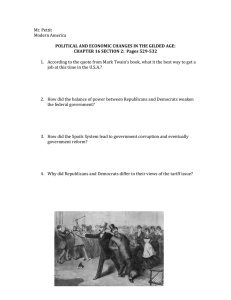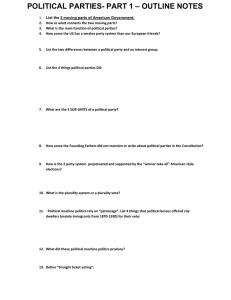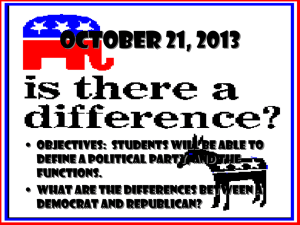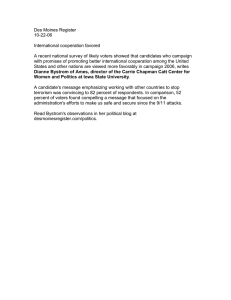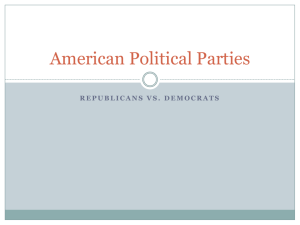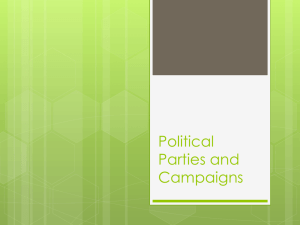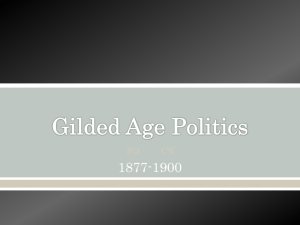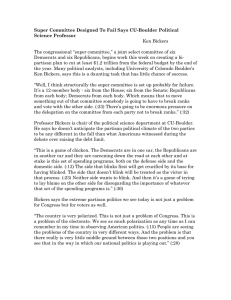Chapter 5 Politics and Government, 1877-1900 Lecture 1 (p. 110-116)
advertisement
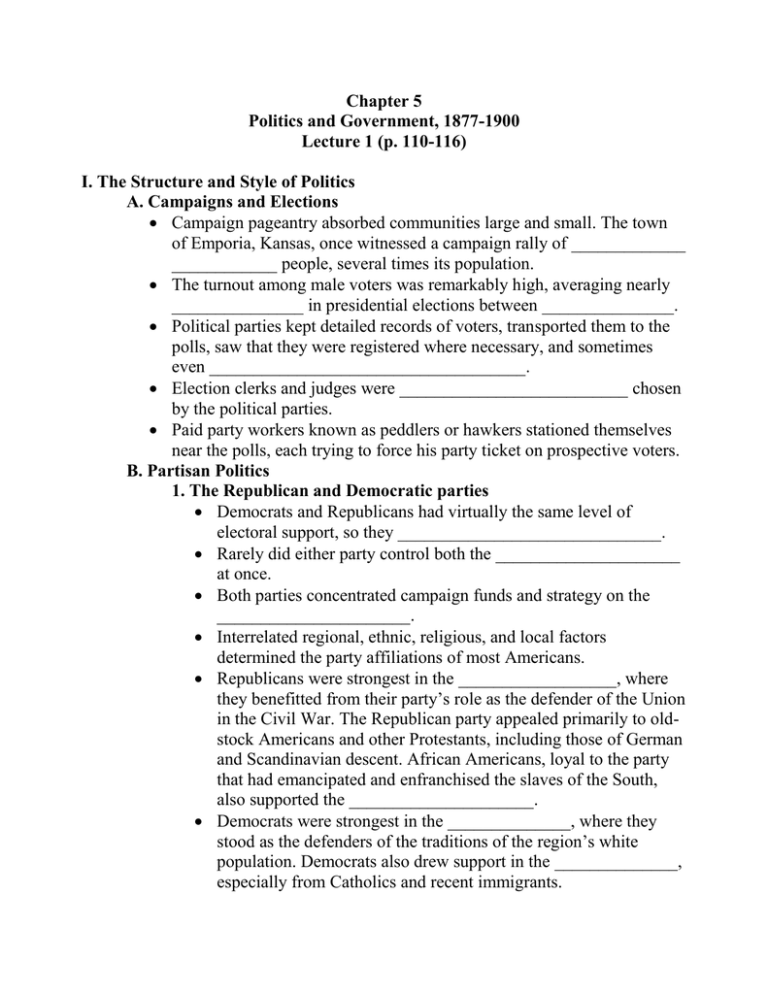
Chapter 5 Politics and Government, 1877-1900 Lecture 1 (p. 110-116) I. The Structure and Style of Politics A. Campaigns and Elections Campaign pageantry absorbed communities large and small. The town of Emporia, Kansas, once witnessed a campaign rally of _____________ ____________ people, several times its population. The turnout among male voters was remarkably high, averaging nearly _______________ in presidential elections between _______________. Political parties kept detailed records of voters, transported them to the polls, saw that they were registered where necessary, and sometimes even ____________________________________. Election clerks and judges were __________________________ chosen by the political parties. Paid party workers known as peddlers or hawkers stationed themselves near the polls, each trying to force his party ticket on prospective voters. B. Partisan Politics 1. The Republican and Democratic parties Democrats and Republicans had virtually the same level of electoral support, so they ______________________________. Rarely did either party control both the _____________________ at once. Both parties concentrated campaign funds and strategy on the ______________________. Interrelated regional, ethnic, religious, and local factors determined the party affiliations of most Americans. Republicans were strongest in the __________________, where they benefitted from their party’s role as the defender of the Union in the Civil War. The Republican party appealed primarily to oldstock Americans and other Protestants, including those of German and Scandinavian descent. African Americans, loyal to the party that had emancipated and enfranchised the slaves of the South, also supported the _____________________. Democrats were strongest in the ______________, where they stood as the defenders of the traditions of the region’s white population. Democrats also drew support in the ______________, especially from Catholics and recent immigrants. Republicans identified their party with ______________________ _________ and attacked the Democrats as an “alliance between the embittered South and the slums of the Northern cities.” Democrats portrayed themselves as the _____________________ ________________ and “personal liberties,” a theme that appealed both to the racism of white Southerners and the resentment immigrants felt about the nativist meddling the Republicans favored. Both major parties had party machines, especially at the local level, led by __________________. These machines not only controlled city politics but also municipal government. 2. Late nineteenth-century third parties Third parties organized around specific issues or groups. The Prohibition party championed the _______________ but also introduced many important reform ideas into American politics. Some _____________________ formed larger but shorter lived third parties, charging that Republican and Democrats had failed to respond to _______________________________ or, worse still, had deliberately promoted powerful business interests at the expense of ordinary Americans. The Greenback party of the 1870s denounced “the infamous financial legislation which takes all from the many to enrich the few.” Its policies of __________________________ (to stimulate and democratize the economy) attracted supporters from Maine to Texas. The most significant third party was the _____________________ of the 1890s. C. Associational Politics 1. The Grange Farmers organized the ____________________, known familiarly as the ____________. Its campaign for public regulation to control the rates charged by _________________________ helped convince Midwestern states to pass the so-called ______________. 2. Industrialists’ associations Organizations such as the __________________________ and the __________________________ lobbied Congress for high tariff laws and made campaign contributions to friendly politicians of both parties. 3. The Mugwumps and the National Civil Service Reform League A small group of conservative reformers known derisively as Mugwumps devoted most of their efforts to campaigning for ____________________________________________________. The Mugwumps organized the National Civil Service Reform League to ______________________, _______________ and state legislatures, and endorse sympathetic candidates. 4. Women’s political organizations Susan B. Anthony and others formed groups to lobby Congress and state legislatures for constitutional amendments extending the _______________________. The leading organizations merged in 1890 as the National American Women Suffrage Association. With petition campaigns, demonstrations, and lobbying, women’s social service organizations sought to remedy poverty and disease, ________________________________, and provide day nurseries for the children of workingwomen. The Women’s Christian Temperance Union (WCTU) gained a massive membership campaigning for ___________________. The WCTU also pushed for improved health conditions and workplace and housing reforms.
